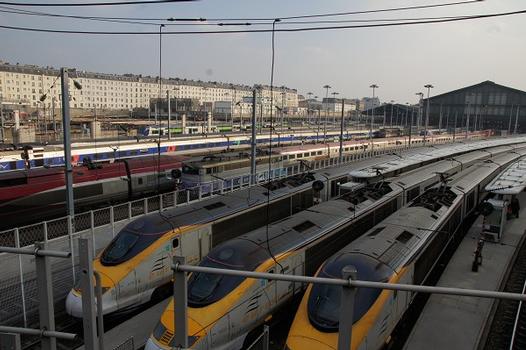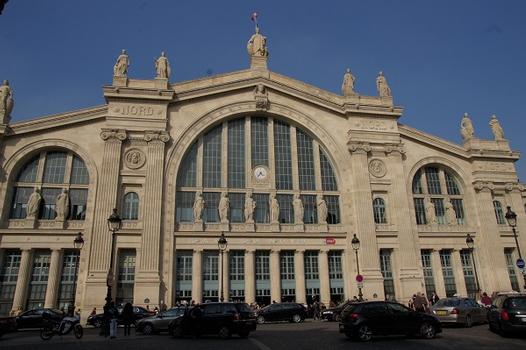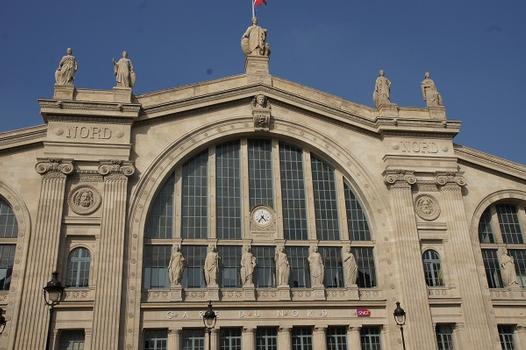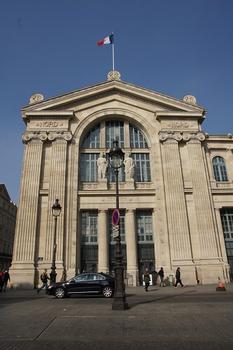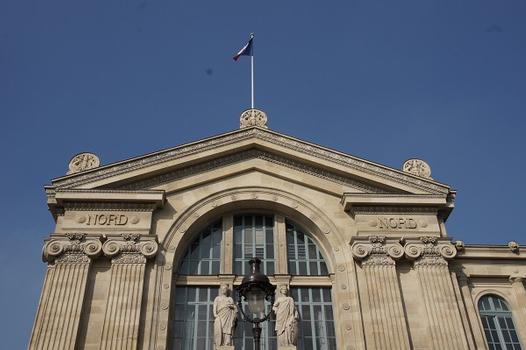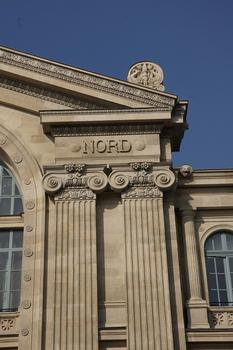General Information
| Official designation: | Ligne nouvelle 3 (LN3) |
|---|---|
| Beginning of works: | 1989 |
| Completion: | 1993 |
| Status: | in use |
Project Type
| Function / usage: |
High-speed rail line |
|---|
Location
| km | Name |
| 3.567 |
Technical Information
Dimensions
| length | 333 km | |
| number of stations | 3 | |
| number of bridges | 297 |
Design Loads
| design speed | 300 km/h (350 km/h) |
Cost
| cost of construction | French Franc 18 500 000 000 |
Chronology
| 23 May 1992 | Line completed. |
|---|
Excerpt from Wikipedia
The LGV Nord (Ligne à Grande Vitesse) is a French 333-kilometre (207 mi)-long high-speed rail line, opened in 1993, that connects Paris to the Belgian border and the Channel Tunnel via Lille.
With a maximum speed of 300 kilometres per hour (190 mph), the line appreciably shortened rail journeys between Paris and Lille. Ist extensions to the north (Belgium, the Channel Tunnel) and the south (via the LGV Interconnexion Est) have reduced journey times to Great Britain and Benelux and for inter-regional trips between the Nord (Pas de Calais) region and the southeast and southwest of France.
Ist route is twinned with the A1 for 130 kilometres (81 mi). As it is mostly built in flat areas, the maximum incline is 25 metres per kilometre (2.5%). And that's why the line was given ist official nickname, The A1 Highway.
Of all French high-speed lines the LGV Nord sees the widest variety of high-speed rolling stock: the TGV Sud-Est, TGV Réseau, TGV Atlantique, TGV Duplex, Eurostar e300, Eurostar e320, Thalys PBA and PBKA as well as the local trains. Traffic is controlled by the Lille rail traffic centre.
Route
The LGV Nord begins at Arnouville-lès-Gonesse, 16.6 kilometres (10.3 mi) from the Gare du Nord on the Paris–Lille railway line. At Vémars, the LGV Interconnexion Est joins it via a triangular junction, leading to Charles de Gaulle Airport and Marne-la-Vallée-Chessy; this enables direct trains from London and Amsterdam to Disneyland Paris.
After passing east of the forest of Ermenonville over the viaduc de Verberie, it joins the A1 around Chevrières and accompanies it to the Lille suburbs.
At Ablaincourt-Pressoir (Somme), a new station, Gare TGV Haute-Picardie, is served only by inter-regional TGVs. At Croisilles, Pas-de-Calais, a junction leads to the Agny link towards Arras. The LGV crosses the A1 autoroute at Seclin (Nord).
At Fretin, a triangular junction links the LGV to the Lille-Brussels HSL 1 high-speed line eastwards, crossing the border at Wannehain and joining the conventional network at Lembeek, south of Brussels. After the Fretin junction, the LGV has a connection to the conventional network at Lezennes, near Lille. This junction is used for TGVs terminating at Lille, which use Lille-Flandres. TGVs that continue beyond Lille, as well as some Eurostar services, stop at Lille-Europe instead. Non-stop Eurostars pass through a tunnel under the city of Lille at 200 kilometres per hour (120 mph).
The line passes south of Armentières and north of Hazebrouck. At Cassel, a link provides a connection with Dunkirk. The LGV continues west, crossing the A26 autoroute at Zouafques and ends at Calais-Fréthun, at the Eurotunnel terminal. This enables TGV service to Calais and Eurostars through the Channel Tunnel to London. The TGVs continue to Calais-Ville or reverse in either Calais stations and go on to Boulogne-sur-Mer and Étaples-Le Touquet and Rang-du-Fliers-Verton. The route was much criticised, particularly by those in the Picardy region. The LGV crosses the region without a stop; Amiens in particular would have liked to have been on the line. The government judged a route via Amiens to be impracticable, as the Lille route demanded a straight line between Paris and Lille in order to give a reasonable Paris-Lille-London journey time. The LGV Picardie project would address this issue by serving Amiens, and would reduce the Paris–London journey time to less than 2 hours.
Stations
The LGV Nord serves the following stations:
- Gare du Nord (Paris)
- Gare TGV Haute-Picardie1
- Gare d'Arras²
- Gare de Lille-Europe
- Gare de Calais-Fréthun
1 Haute-Picardie station has been nicknamed "Gare des Betteraves" or "Beetroot Station," since it is located in the middle of nowhere and is only accessible by good road connections. Amiens wanted a station closer to the town centre, stopping at Gare d'Amiens. ² Arras station is reached via a branch of the LGV Nord that splits off near the village of Croisilles.
History
- 1984 (1984): The Lyon-Lille connection by TGV began, using conventional lines between the Ile-de-France and Lille.
- 29 September 1989 (1989-09-29): declaration of public utility
- 2 September 1991 (1991-09-02): commencement of tracklaying
- 9 September 1992 (1992-09-09): catenary in service
- 20 October 1992 (1992-10-20): first trials with TGV Atlantique trainset 301
- 23 May 1993 (1993-05-23): service commences between Paris and Arras
- 21 December 1993 (1993-12-21): TGV 7150 from Valenciennes to Paris, operated by set 511, derailed at 300 kilometres per hour (190 mph) at the site of TGV Haute Picardie station (before it was built). Rain had caused a hole to open up under the track; the hole dated from the First World War but had not been detected during construction. The front power car and the front four carriages derailed, but remained aligned with the track. Out of the 200 passengers, one was slightly injured.
The line was designed to facilitate European connections. The foreseen opening of the Channel Tunnel made it a project of the utmost urgency, leading to an acceleration of work. It opened in 1993, a year before the tunnel, from Arnouville to Fréthun; the Belgian section followed in 1997.
Text imported from Wikipedia article "LGV Nord" and modified on July 22, 2019 according to the CC-BY-SA 4.0 International license.
Participants
Relevant Web Sites
Relevant Publications
- Bilan et reflexions. In: Travaux, n. 677 (June 1992), pp. 79.
- (1992): Le génie civil du TGV Nord. In: Travaux, n. 675 (April 1992), pp. 129-141.
- (1992): Ligne nouvelle du TGV Nord. Franchissement du canal de la Deûle. In: Travaux, n. 675 (April 1992), pp. 142.
- (1992): Ligne TGV Nord. Traversée de Lille du PK 13,457 au PK 14,038. Le viaduc de Saint-André (Nord). In: Travaux, n. 681 (November 1992), pp. 32-41.
- L'organisation des chantiers et des études d'exécution. In: Travaux, n. 677 (June 1992), pp. 23-32.
- About this
data sheet - Structure-ID
10000006 - Published on:
18/05/1999 - Last updated on:
28/05/2021


